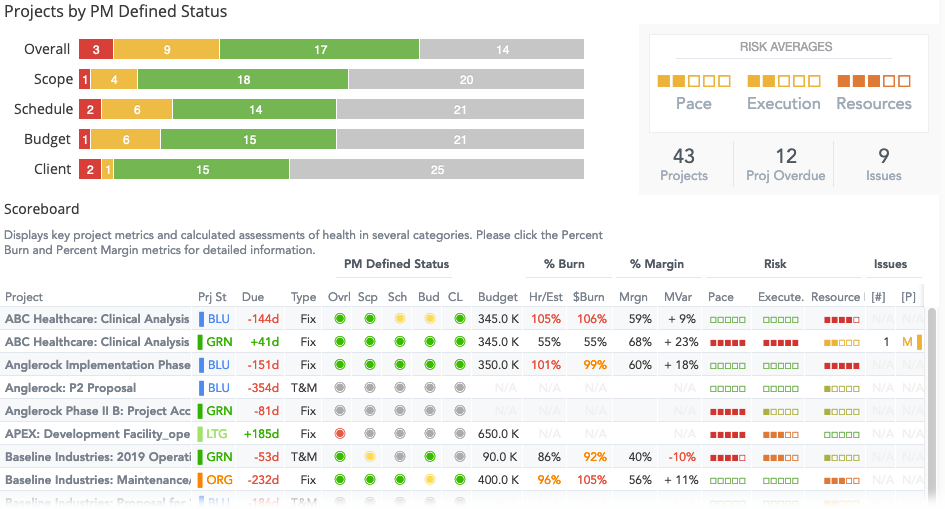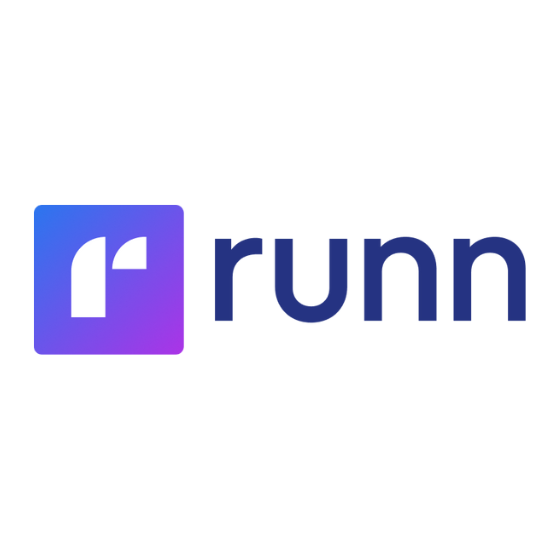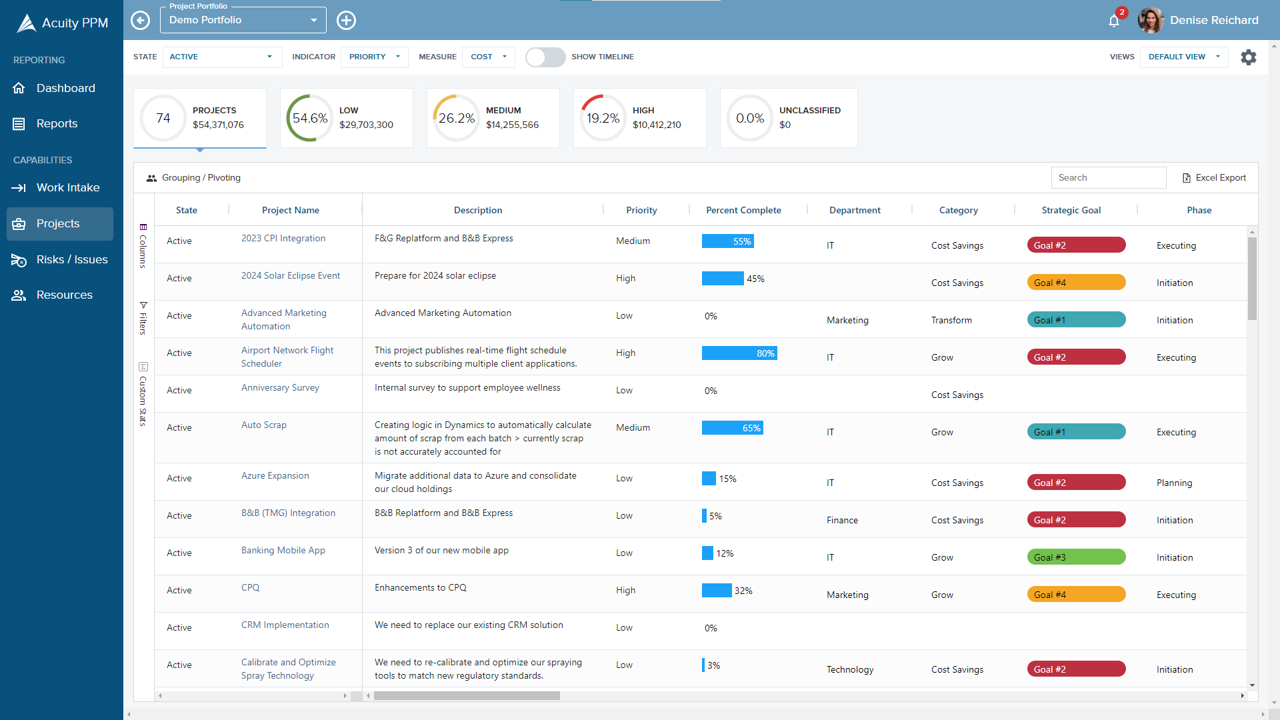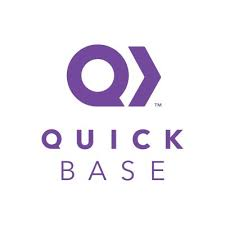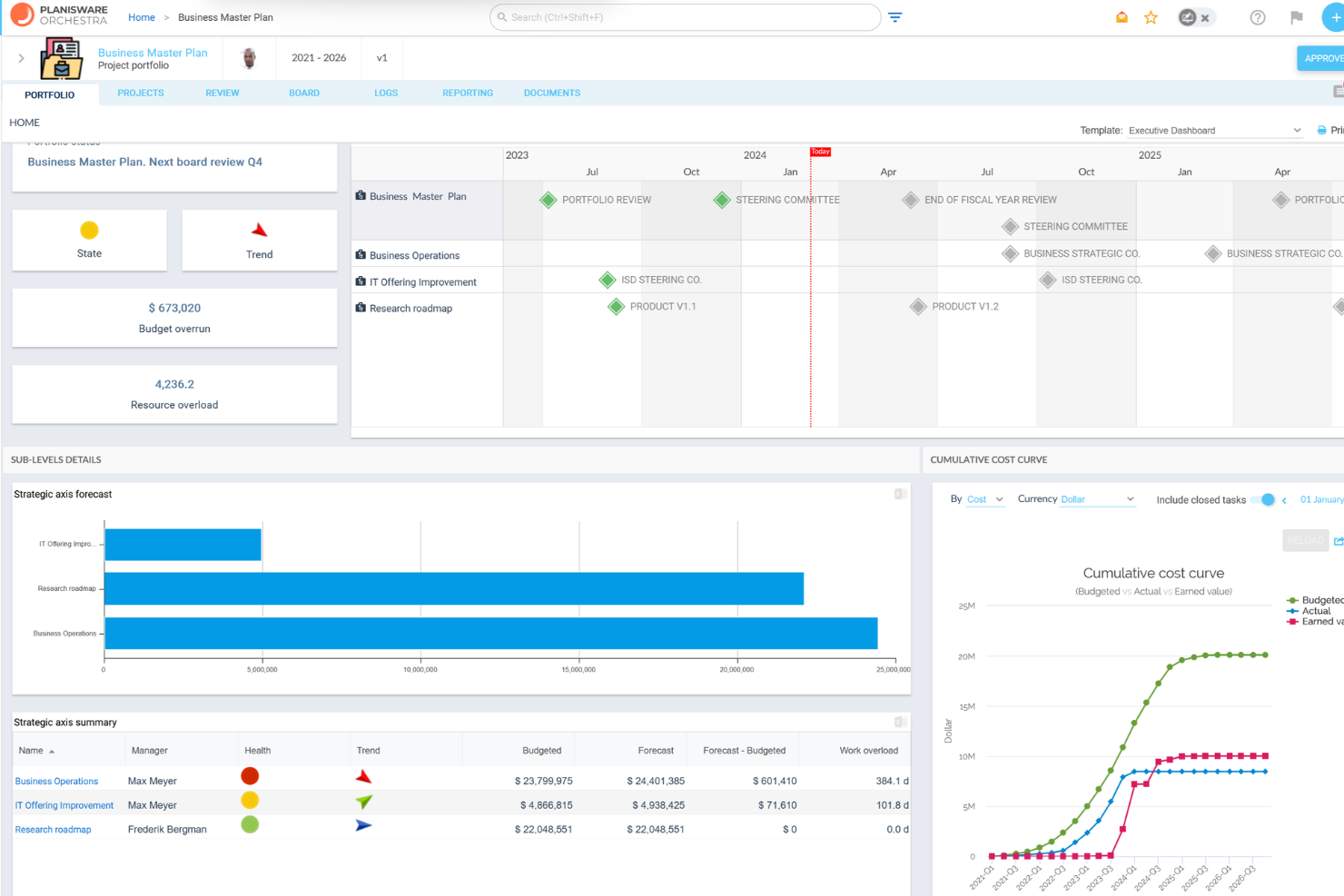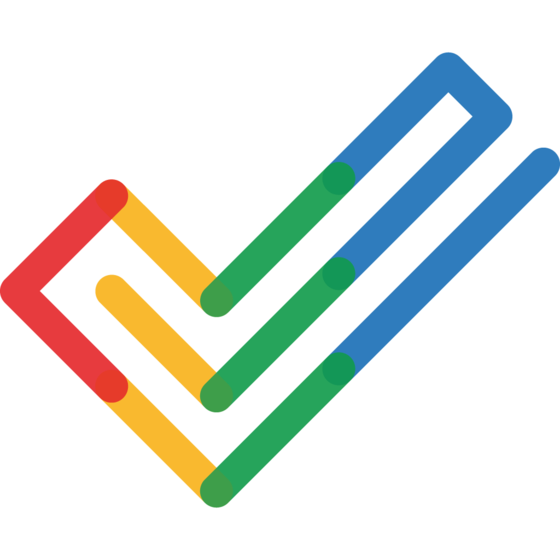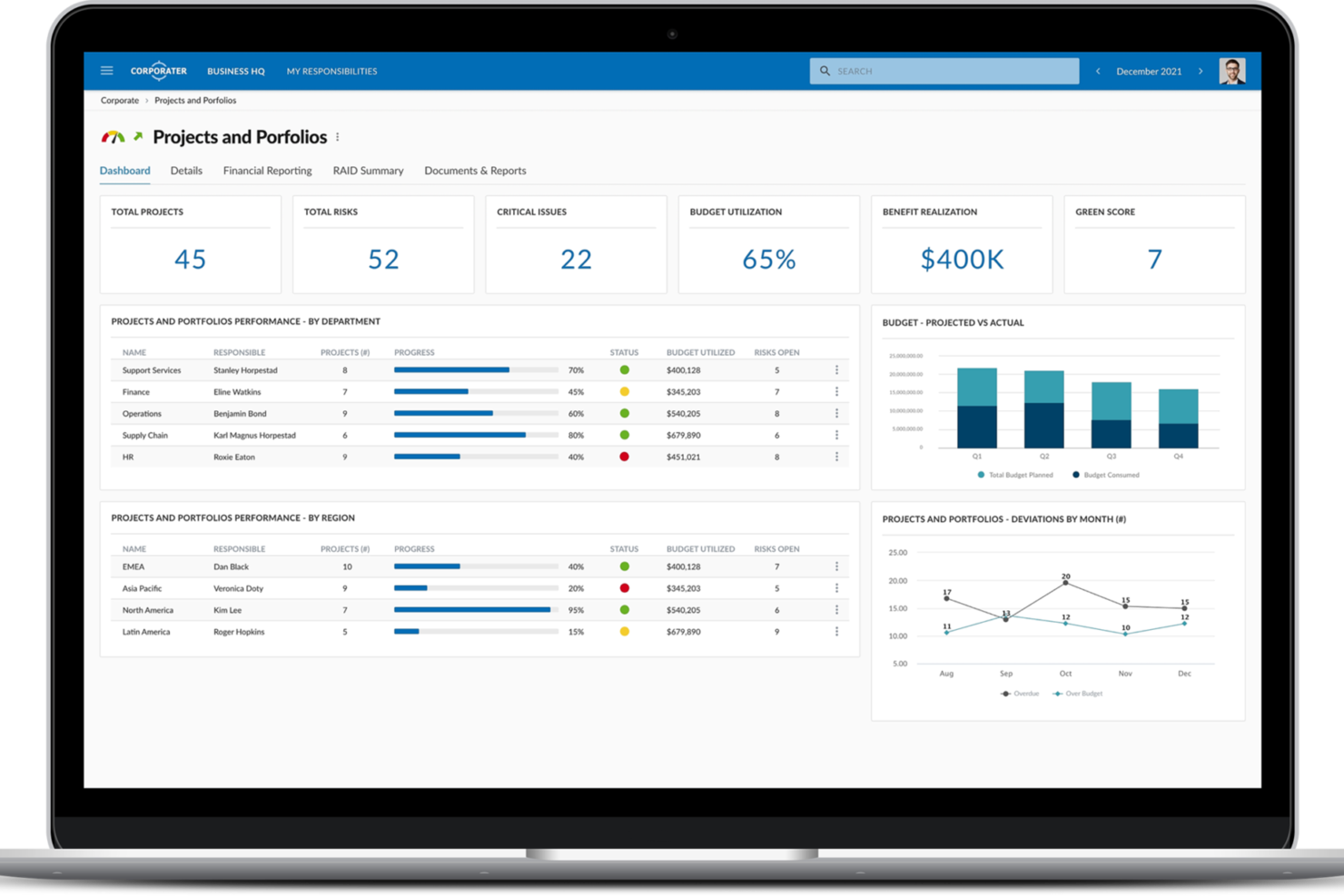10 Best Portfolio Management Tools Shortlist
Here's my pick of the 10 best software from the 25 tools reviewed.
Get free help from our project management software advisors to find your match.
With so many different project portfolio management tools available, figuring out which is right for you is tough. You want to ensure that all projects align with the overall business strategy and optimize resource allocation but need to figure out which tool is best. I've got you! In this post I'll help make your choice easy, sharing my personal experiences using dozens of different portfolio management tools with large projects, with my picks of the best project portfolio management tools.
You Can Trust Our Project Portfolio Management Tools Reviews
We’ve been testing and reviewing PPM software since 2012. As project managers ourselves, we know how critical and difficult it is to make the right decision when selecting software.
We invest in deep research to help our audience make better software purchasing decisions. We’ve tested more than 2,000 tools for different Project Management use cases and written over 1,000 comprehensive software reviews. Learn how we stay transparent & our PPM tools review methodology.
The Best PPM Tools Comparison Chart
Here’s a table you can use to compare all the tools we just covered in the overviews.
| Tools | Price | |
|---|---|---|
| Celoxis | Starts at $25/mo for cloud. Contact sales for on-premise quotes. | Website |
| Kantata | Pricing upon request | Website |
| Runn | From $10 /person managed/month | Website |
| Visor | From $9/user/month | Website |
| Ravetree | From $29/user/month | Website |
| Acuity PPM | From $599/month | Website |
| QuickBase | From $600/month (billed annually), which equates to $25/user/month with a minimum requirement of 20 users. This is for the Team plan, which includes core features suitable for smaller teams. For larger organizations or those needing advanced features, QuickBase offers higher-tier plans, and pricing for these can be obtained upon request. | Website |
| Planisware Orchestra | Pricing upon request | Website |
| Zoho Projects | From $5/user/month (billed annually). | Website |
| Corporater | Pricing upon request | Website |

Compare Software Specs Side by Side
Use our comparison chart to review and evaluate software specs side-by-side.
Compare SoftwareHow To Choose Project Portfolio Management Software
With so many different project portfolio management solutions available, it can be challenging to make decisions on what project portfolio management tool is going to be the best fit for your needs.
As you're shortlisting, trialing, and selecting project portfolio management tools consider the following:
- What problem are you trying to solve - Start by identifying the project portfolio management tools feature gap you're trying to fill to clarify the features and functionality the project portfolio management tool needs to provide.
- Who will need to use it - To evaluate cost and requirements, consider who'll be using the software and how many licenses you'll need. You'll need to evaluate if it'll just be the project team, or the whole organization that will require access. When that's clear, it's worth considering if you're prioritizing ease of use for all, or speed for your project portfolio management tools power users.
- What other tools it needs to work with - Clarify what tools you're replacing, what tools are staying, and the tools you'll need to integrate with, such as accounting, CRM or HR software. You'll need to decide if the tools will need to integrate together, or alternatively, if you can replace multiple tools with one consolidated project portfolio management tool.
- What outcomes are important - Consider the result that the software needs to deliver to be considered a success. Consider what capability you want to gain, or what you want to improve, and how you will be measuring success. For example, an outcome could be the ability to get greater visibility into performance. You could compare project portfolio management tools features until you’re blue in the face but if you aren’t thinking about the outcomes you want to drive, you could be wasting a lot of valuable time.
- How it would work within your organization - Consider the software selection alongside your workflows and delivery methodology. Evaluate what's working well, and the areas that are causing issues that need to be addressed. Remember every business is different — don’t assume that because a tool is popular that it'll work in your organization.
Best Portfolio Management Tools Reviews
Any project portfolio management solution from this list should help you with managing projects and strategic alignment across your portfolio.
Celoxis is an all-in-one project portfolio management software and work collaboration platform that is a full-featured project portfolio management system, very intuitive and easy to use for teams of all sizes.
Why I picked Celoxis: You get comprehensive resource management capabilities. It lets you easily allocate resources based on skills, roles, and availability as well as view cross-portfolio resource workload to optimally utilize your workforce. You will find tools for capacity planning, demand management, and project requests. When it comes to tracking project financials, you can automatically get cost/revenue estimates from your plans. You can also track budgets, costs, and profits in real-time as well as plug billing leaks by timely invoicing your clients.
Celoxis’ reporting features let you slice, dice, and visualize data your way. You can get aggregated information about your projects with fully customizable portfolio planning dashboards. Celoxis comes pre-built with common workflows to help bug/issue tracking and risk management. These workflows are very adaptable to suit your organizational processes without having to resort to emails and spreadsheets.
Celoxis Standout Features & Integrations
Features include a real-time project tracker, task management, resource availabilities and utilization, timesheets, project finances, risks, issues and to-dos.
Integrations include hundreds of popular business applications through first-class integration connectors and web-based API. This includes critical platforms like Jira, Salesforce, QuickBooks Online, Excel, Slack, Google Apps, and more.
Celoxis Plans & Pricing
SaaS costs $25/user/month, and on-premise costs are available upon request. Both require a minimum 5-user sign-up and come with a 30-day free trial.
The Kantata Professional Services Cloud is the professional services solution formed by the merger of Mavenlink & Kimble.
Why I picked Kantata: It supports resource management, project management, financial management, and business intelligence. Additionally, it is designed to foster team collaboration and bring your team together in one view.
Their project portfolio management capabilities provide an overview of all your projects in a customizable view that is located in a tab inside the Project Health dashboard. In it, you will find RAG indicators providing quick info on overall health status, margin %, burn rates, risk, and more. Additionally, each item in your scoreboard can take you to more detailed information with a simple hover and click.
Kantata Standout Features & Integrations
Features include resource forecasting, real-time utilization, capacity management, skills management, scenario planning, and role-based planning.
Integrations include pre-built connections with these tools: Expensify, G Suite, Xero, Salesforce, Netsuite, Jira, Hubspot, Slack, Concur, Dynamics 365, Qualtrics, Quickbooks, and Sage Intacct. They also provide an integration platform called M-Bridge that’s designed to simplify integration between Kantata and other business apps like CRM, HCM, and financial software.
Note: Kantata is a viable option for teams with over 30 people as per their pricing form.
Runn is a real-time resource planning and PPM software with integrated time tracking and powerful forecasting capabilities.
Why I picked Runn: The software is extremely intuitive and its Gantt view has drag-and-drop features and a colorful user interface. The free version of this software lets you build unlimited projects and offers a project portfolio view, which makes it perfect for small project teams.
Runn makes the data dynamic and visual. Charts and reports update as you plan your projects, and you can see insights like capacity, workload, availability, and billable and non-billable utilization. Finally, you can keep tabs on KPIs like utilization, project variance, and overall financial performance.
Runn Standout Features & Integrations
Features include resource scheduling, capacity management, project scheduling, timesheets, forecasting, and reporting. All features are available in the free plan.
Integrations include Harvest, WorkflowMax, and Clockify for importing project, client, and people data and syncing time entries. With Runn’s API, you can build your own integration to send data across your favorite tools.
Runn Plans & Pricing
The free version is available for up to 5 users. Paid plans start at $10/user/month.
Visor is a workspace tool designed to integrate with multiple SaaS applications, enabling users to access and manage their data from a single platform. It stands out by offering a unified user experience that connects people with data, and features custom views and visualizations, particularly for nested Jira data, with bi-directional integration to facilitate data import and export.
Why I Picked Visor: I selected Visor because it offers a flexible workspace that integrates with multiple SaaS applications, which is critical for bringing together diverse data and team collaboration in one place. What differentiates Visor is its ability to sync with Jira, providing a spreadsheet-like environment that supports the creation of custom views and visualizations that remain up-to-date, which is particularly useful for project management and roadmapping.
Visor Standout Features & Integrations
Features include API, dashboards, data export/data import, data visualization, external integrations, Gantt charts, project management, task scheduling/tracking, resource management, and third-party plugins/add-ons.
Integrations include HubSpot, Jira, and Salesforce.
Visor Pricing & Plans
Paid Visor plans start at $9/user/month, and they also offer a free forever plan that includes the basics.
Ravetree is a comprehensive work management platform that combines project management features with resource planning and client management tools.
Why I picked Ravetree: This software is a good option for professional services businesses or companies managing multiple portfolios across various clients. I added it to my list because of its capacity to bring together resource planning and client management in the same system you use to plan and manage your projects and tasks.
The project management features in the platform allow you to break projects up into tasks, and assign them to specific team members. Your tasks can be outlined with specific action items and checklists to keep everyone on track. Team members will be sent notifications regarding their upcoming tasks, and you can keep an eye on resource utilization with a timeline view. The software's time tracking lets you easily compare your estimates vs. time spent on specific projects and tasks. This data can then be used to inform your resource planning in the future.
As for client-focused features, the system includes a CRM where you can store all of your client contact data. You can also set up client portals to provide a self-serve option where clients can receive updates and stay informed on project progress.
Ravetree Standout Features & Integrations
Features include Kanban boards, timeline and calendar views, repeating tasks, dependencies, request forms, client portals, CRM, resource planning, billing and invoicing, budget management, and file management.
Integrations include Box, Dropbox, Facebook, HubSpot, Instagram, Github, Google Drive, Gmail, OneDrive, Outlook, QuickBooks, and Stripe.
Ravetree Plans & Pricing
Paid plans start from $29 per user, per month, and a 7-day free trial is available.
Acuity PPM is a lightweight portfolio management solution that is a great alternative to spreadsheets.
Why I picked Acuity PPM: The tool includes a beautiful interface to help you manage your project portfolio, as well as fundamental capabilities for getting visibility into your entire project portfolio, managing work intake, prioritizing projects, tracking project performance and status reports, and managing resource capacity.
PMOs can track project portfolios and get insights on project status, store status reports in one place, and view status history across your portfolio. Another great feature is the ability to view portfolio roadmaps and see timing and sequencing for current and potential projects in the portfolio. PMO team members can also score projects using Acuity’s scoring model and then easily prioritize projects.
Acuity PPM Standout Features & Integrations
Features include portfolio tracking, portfolio roadmap, project scoring and prioritization, project request management, and resource capacity planning.
Integrations are only included in the Enterprise plan.
Acuity PPM Plans & Pricing
Pricing starts at $599 per month.
QuickBase is a workflow and project management tool that lets you build custom business applications. It's suitable for businesses of all sizes and stages, including those managing multiple portfolios.
Why I picked QuickBase: I included this platform in my list because it can help ensure consistency and compliance in your workflows across your company's portfolio. By crafting standardized applications for your business, you create best practices for employees across teams and departments to adhere to.
The software also helps you streamline and automate your core business processes. You can set up automations and integrations using the builder as well, driving efficiency and reducing manual workloads (and the risk for manual error). The software is flexible enough to suit the needs of different types and sizes of teams in various industries.
QuickBase Standout Features & Integrations
Features include a no-code app builder, data syncing and reporting, template library, team collaboration tools, personalized dashboards, mobile app, audit logs, and data encryption.
Integrations include Outlook, Microsoft Teams, Google Workspace, Slack, Box, Dropbox, OneDrive, Trello, Asana, Jira, Zendesk, and Docusign, among others.
QuickBase Plans & Pricing
Paid plans start from $35 per user, per month, and a 30-day free trial is available.
Planisware Orchestra is a project portfolio management (PPM) software designed to help organizations manage and prioritize their projects. It is designed to handle complex project portfolios and can be tailored to meet the specific requirements of different organizations and industries.
Why I picked Planisware Orchestra: One of the key features is its dynamic portfolio analysis capabilities, which allow managers to categorize, prioritize, and balance projects based on strategic business objectives. This aligns projects directly with corporate strategies, ensuring that all initiatives drive value and meet predefined business goals. The platform also facilitates portfolio scenario planning with advanced simulation and forecasting tools.
Additionally, Planisware Orchestra provides a structured yet flexible framework to help PMOs mature their project portfolio management practices. From standardized processes and methodologies to a fully customizable interface that adapts to various project management maturity levels, the software supports development toward more advanced PPM practices.
Planisware Orchestra Standout Features & Integrations
Features include APIs, collaboration tools, governance and compliance mechanisms, multi-project management, schedule management, resource and cost management, reporting and dashboards, Kanban board, forecasting, customizable templates, approval process control, and more.
Integrations include Microsoft Office 365, Microsoft Teams, Google Workspace, Oracle NetSuite, Hyperion, JD Edwards, Tableau, Qlik, Workforce, ADP, SAP, Jira, Salesforce, HubSpot, and more.
Zoho Projects is an award-winning project management and collaboration tool from Zoho. It offers flexibility and customizations to suit the needs of traditional project managers as well as agile teams.
Why I picked Zoho Projects: The resource utilization charts enable you to easily view the workload of team members and you can create and balance the workload with just a click of a button. Fix hourly rates, create invoices and have an eye on your project budget. Forecast project budget, keep track of your timelines with baselines and critical path analysis.
The interface and modules are highly customizable. All aspects of the UI from theme colors to arrangement and visibility of the various modules can be changed to suit a user's preferences. Zoho projects also offer free onboarding for its customers and a comprehensive online help guide for all users.
Zoho Projects is one of the few PPM tools that allow the creation of dependencies between projects. The portfolio widget on the dashboard helps users to get an overview of all projects at a glance. Zoho Projects stands out in cases where there are multiple hand-offs involved. It is especially popular among IT companies, consultants and education organizations. With Blueprints, users can create and automate workflows, notifications, and escalations.
Zoho Projects Standout Features & Integrations
Features include task management, task automation, blueprints, time and issue tracking, reporting, and forums for detailed discussions with your team.
Integrations. Being part of Zoho's ecosystem allows Projects to connect to several of Zoho's own services such as Zoho Books, Zoho CRM, and Zoho's finance suite. The new Zoho marketplace allows 3rd party integrations as well.
Zoho has a freemium version upto 3 users for 2 projects. No credit card information required.
Corporater provides a project and portfolio management solution that is designed to bring together all your projects, portfolios, teams, and strategies into a central system, digitize PMO and to improve efficiency across your entire organization, especially when it comes to the project and portfolio lifecycle.
Why I picked Corporater: This project portfolio management (PPM) software allows you to have a more holistic oversight over your organization’s existing project portfolio programs, set up PMO with features like PPM dashboards, portfolio management and monitoring, resource planning and allocation, project management and execution, project and portfolio risk management, automated workflows, and analytics. These features, along with other inbuilt capabilities such as risk assessments, data roll-ups and collaboration, can help ensure that all your projects and business-oriented goals are aligned strategically and communicated across teams and departments.
This project and portfolio management software from Corporater is an integrated digital solution that gives businesses the ability to engage in efficient planning, execution, and monitoring of projects and project portfolios, regardless of scale or complexity. The tool provides them with complete control and enables the completion and delivery of projects and project portfolios across their enterprise on time and budget.
The Corporater PPM software also allows senior management to bring together their project portfolios and corporate strategies, prioritizing key initiatives and programs based on existing strategic goals. As they align project portfolios with corporate strategy, senior staff members can leverage reliable insights to make data-driven decisions that drive better business outcomes.
Corporater Standout Features & Integrations
Features include executive dashboards, budgeting, prioritization, task management solutions, data visualization, project risk management, risk heat maps, project portfolio optimization, document management, third-party system data integration, version control, and value driver mapping.
Integrations include Excel, CSV, SQL, MDX, Web-Services, SFTP and more, including support for third-party JDBC drivers
Corporater Plans & Pricing
Corporater pricing is available upon request, and a free demo is available.
Other Portfolio Management Tools
These PPM tools did not make it to the top 10 but are worth considering if you want to expand your tool research.
- Forecast
Best PPM tool for AI and automation capabilities
- Oracle Primavera
Best PPM tool for enterprise
- Accelo
Best PPM tool for automations
- ProjectManager.com
Best for built in and custom report templates
- Planview Clarizen
Best PPM for medium to large enterprises
- Adobe Workfront
Best PPM tool for service teams
- Portfoleon
Best PPM tool for growing organizations
- KeyedIn
Best PPM tool for user experience and user interface
- LiquidPlanner
Best for managing shared resources and projects across the portfolio
- Sciforma
Best for product development and IT
- Proggio
Patent based Enterprise PPM solution for professionals
- RAIDLOG.com
Best for risk management and monitoring
- Primetric
Best for IT service companies & digital agencies
- WorkOtter
Best PPM tool for capacity planning
- Bubble
Best PPM tool for project and portfolio prioritization
Related Project Management Reviews
- Project Management Software
- Resource Management Software
- Workflow Automation Software
- Time Tracking Software
- Task Management Software
- Collaboration Tools
Selection Criteria For Project Portfolio Management Tools
Selecting project portfolio management (PPM) tools requires a nuanced understanding of both the software's capabilities and how those capabilities align with specific business needs.
Through my hands-on trials and comprehensive research, I've identified key criteria that are crucial when evaluating these tools. These criteria ensure that the selected PPM tool not only offers the essential functionalities but also addresses common pain points, facilitating the alignment of project efforts with company goals.
Core Project Portfolio Management Tools Functionality (25% of final scoring): Common features for project portfolio management tools typically include project scheduling, resource allocation, budget management, risk management, collaboration tools, dashboards and reporting, portfolio optimization, time tracking, document management, and integration with other business tools.
To be considered for inclusion on my list of the best project portfolio management tools, the solution had to support the ability to fulfill common use cases. These include:
- Efficiently managing multiple projects and resources to avoid overallocation
- Aligning projects with strategic business goals to ensure relevance and value
- Providing real-time visibility into project status and performance for timely decision-making
- Facilitating collaboration across teams and stakeholders to keep projects on track
- Streamlining reporting and analytics to assess project impact and ROI
Additional Standout Features (25% of final scoring): I looked at any features that incorporate new technologies or move the needle in terms of innovation in this space. Examples include advanced AI-driven analytics for predictive insights into project success and risks and tools that introduce innovative approaches to collaboration. Finally, tools that push the envelope in usability, such as employing natural language processing for easier task updates or voice commands.
Usability (10% of final scoring): I prioritize tools that balance sophisticated features with intuitive design, ensuring that users can leverage the full range of functionalities without a steep learning curve.
I also look for interfaces that simplify complex data presentation, such as drag-and-drop scheduling tools and dashboards that can be customized without IT support.
Onboarding (10% of final scoring): This criterion involves evaluating how quickly and efficiently new users can get up to speed with the tool, including the availability of training materials like videos, templates, and product tours.
Customer Support (10% of final scoring): Assessing the responsiveness, availability, and expertise of the customer support team, including the range of support channels (email, chat, phone) and the presence of a knowledge base or community forum.
Value For Money (10% of final scoring): Comparing the tool's pricing structure with its feature set, scalability, and performance to ensure buyers receive optimal value for their investment, considering both current and future needs.
Customer Reviews (10% of final scoring): Analyzing feedback from current and past users to gauge satisfaction levels, particularly focusing on reliability, user experience, and the impact on project outcomes.
Each tool selected under this rigorous process carefully balances core functionalities with specific business needs to ensure the selected tool drives value.
Trends In Project Portfolio Management Tools For 2024
As businesses strive for efficiency, agility, and strategic alignment, PPM tools have become crucial in providing visibility, enhancing decision-making, and demonstrating how individual projects contribute to overarching goals. This summary highlights key trends in PPM tools.
Enhanced Integration and Automation: Increased emphasis on seamless integration with other business tools, including CRM, ERP systems, and collaboration platforms, to streamline workflows and reduce manual data entry.
Advanced Analytics and Reporting: Advanced analytics and customizable reporting features are rapidly evolving to offer deeper insights into portfolio performance, resource allocation, and risk management. Recent upgrades include AI-infused analytics for predictive analysis of project outcomes, and more intuitive, customizable dashboards that allow stakeholders to visualize how projects align with business objectives.
Focus on Strategic Alignment: Tools are increasingly incorporating features that help organizations align projects with strategic goals and demonstrate this alignment to stakeholders. New functionalities include goal-setting frameworks, outcome-based planning tools, and alignment scorecards that map project outputs directly to strategic objectives.
Declining Trends
Traditional Documentation: Traditional, heavyweight documentation and reporting features are becoming less important, as users demand real-time, digestible insights over extensive, static reports. Shift towards dynamic dashboards and visual project tracking tools, reducing the reliance on lengthy, detailed report generation.
In summary, the project portfolio management tools are becoming more integrated and automated, with a strong emphasis on user experience and collaboration. This evolution underscores the importance of PPM tools in not just managing projects, but in ensuring they contribute effectively to the strategic goals of the organization.
What Are Project Portfolio Management Tools?
Project portfolio management tools are software that help organizations oversee and manage a collection of projects and initiatives. These tools provide a centralized platform to track the progress, resources, and performance of multiple projects simultaneously. By consolidating project data in one place, they enable managers to view the big picture and make informed decisions about project prioritization, investment, and resource allocation.
Project portfolio management software help businesses align their projects with overall strategic objectives, ensuring that resources are invested in projects that offer the most value. By offering real-time insights into each project's status, these tools aid in identifying potential risks and bottlenecks early, allowing for timely interventions. They also enhance collaboration and communication within teams, as everyone has access to the same updated information.
Features of Project Portfolio Management Tools
Selecting the right project portfolio management (PPM) software is a pivotal decision for organizations aiming to align project initiatives closely with their strategic goals. The ideal PPM tool not only streamlines project execution but also ensures resources are used efficiently and stakeholders stay well-informed. Below, I outline the most critical features to look for in PPM software to achieve these objectives.
- Strategic Alignment Tools: These features ensure that every project contributes directly to the overarching goals of the organization. By aligning projects with company strategy, businesses can prioritize initiatives that offer the highest value.
- Resource management: Like resource scheduling software, PPM software with resource planning will help you make better decisions around project planning at the portfolio level. This includes features for resource allocation, capacity planning, resource utilization, managing timelines, and projections.
- Real-time Dashboards: Dashboards provide instant access to critical project metrics and KPIs. They are crucial for maintaining visibility into project health, enabling timely decisions that keep initiatives on track and aligned with business objectives.
- Collaboration and Communication Tools: These features facilitate seamless interaction among team members and with stakeholders. Clear communication is vital for aligning expectations, resolving issues promptly, and ensuring everyone is working towards the same goals.
- Risk Management: This aspect helps identify, assess, and mitigate project risks. Proactive risk management is key to minimizing surprises and ensuring that projects contribute positively to the company's strategic objectives.
- Portfolio Analytics and Reporting: Advanced analytics and customizable reporting capabilities offer insights into portfolio performance. This intelligence is crucial for evaluating how well projects align with strategic goals and where adjustments might be needed.
- Agile and Flexible Framework Support: Support for various project management methodologies, including Agile and Waterfall, allows organizations to apply the best approach for each project. Flexibility in project management is essential for adapting to changes and achieving strategic objectives.
- Financial Management: Tools that provide visibility into project budgets, costs, and ROI are critical. They ensure that financial resources are allocated wisely, supporting projects that align with strategic priorities and deliver the greatest value.
- Integration Capabilities: The ability to integrate with other enterprise systems (like ERP, CRM, and HR software) ensures that project data is consistent and accessible across the organization. Integration streamlines processes and supports strategic decision-making.
- Security & Compliance: Achieving business objectives requires making informed decisions based on accurate data. Since unwanted visitors can compromise that, I looked at the tool’s compliance with regulations such as GDPR, HIPAA, or SOX. Also, data security certifications and level of permission customizations within each tool.
Selecting a PPM tool with these features is fundamental for organizations focused on delivering strategy-aligned project initiatives. By ensuring efficient use of resources and facilitating easy communication with stakeholders, businesses can better navigate the complexities of modern project management. The right software not only supports the tactical aspects of project execution but also enhances strategic decision-making, ultimately driving success and competitive advantage.
Benefits of Project Portfolio Management Software
Project Portfolio Management (PPM) software is an invaluable tool for today's project managers and organizations aiming to streamline their project processes and align initiatives with their strategic goals. By adopting PPM software, users can enjoy a multitude of benefits that enhance efficiency, visibility, and decision-making. Here are five primary advantages that PPM software offers:
- Enhanced Strategic Alignment: This benefit ensures that all projects contribute directly to the strategic objectives of the organization. PPM software enables users to select and prioritize projects that align with their business goals, ensuring resources are invested in the most impactful initiatives.
- Improved Resource Optimization: By providing a clear overview of resource allocation and availability, PPM software allows for the efficient utilization of personnel, budget, and time. This optimization helps businesses maximize productivity and reduce overhead costs, ensuring projects are delivered on time and within budget.
- Increased Visibility and Control: With real-time dashboards and reporting features, PPM software offers users comprehensive visibility into project performance, timelines, and risks. This increased oversight enables managers to make informed decisions quickly, keeping projects on track and aligned with business strategies.
- Better Risk Management: PPM software aids in identifying, assessing, and mitigating potential risks across the project portfolio. By proactively managing risks, organizations can minimize the impact of uncertainties on their projects, ensuring smoother execution and higher success rates.
- Enhanced Collaboration and Communication: Facilitating seamless communication between team members and stakeholders, PPM software ensures that everyone is on the same page. This fosters a collaborative environment where information is shared freely, leading to more cohesive project teams and better project outcomes.
Adopting PPM software brings a strategic edge to organizations, enabling them to navigate the complexities of project management with greater ease and efficiency. As the demand for streamlined project processes and strategic alignment grows, the role of PPM software in achieving these objectives becomes increasingly vital.
Cost & Pricing For Project Portfolio Management Software
For software buyers new to PPM tools, understanding the various plans and pricing options is essential to making an informed decision. These options typically range from basic, free versions designed for small teams or startups, to more advanced, feature-rich plans tailored to meet the needs of large enterprises. Below, is a table with the common plan options, their average pricing, and the features typically included, to help guide your selection process.
Comparison Table For Project Portfolio Management Software
| Plan Type | Average Price | Common Features Included |
|---|---|---|
| Individual | $10 - $20/user/month | Access for 1 user, basic project management features, limited reporting, and dashboard capabilities |
| Team | $25 - $50/user/month | Project collaboration tools, resource management, enhanced reporting and dashboards, support for multiple users |
| Professional | $50 - $100/user/month | Advanced analytics, portfolio management, risk assessment tools, integration capabilities, unlimited projects |
| Enterprise | Custom Pricing | Customizable features, advanced security options, dedicated support, enterprise-grade scalability |
| Free Option | $0 | Limited projects, basic task management, simple reporting tools, access for a limited number of users |
When choosing a PPM software plan, consider both the immediate and future needs of your organization. Opt for a plan that not only fits your current project management requirements but also offers room for growth as your business evolves.
Project Portfolio Management Tools FAQs
Find answers to common questions other people ask about this topic.
What is PPM?
In project management, PPM is project portfolio management. A single project is the elementary cell of an organization. Zoom out, and we have project management, which is concerned with execution and project delivery. Zoom out more, and we see the various projects that an organization takes on. PPM is concerned with making sure these distinct projects are undertaken in a way that complements one another in terms of resources, timelines, and overall business goals.
The person responsible for PPM is called a portfolio manager.
Find out more about this topic in our beginner’s guide to PPM.
What does a Project Portfolio Manager do?
A project portfolio manager oversees, controls, and leads the tasks associated with project execution within a project portfolio. This person needs the skills of a chess master to adequately lead the team and finish projects, ideally on time and within budget. The responsibility range of this position is immense and often deals with researchers, analysts, and clients as they manage the high-level coordination of projects, following current market trends, and anticipating future ones.
A project portfolio manager can work at a department level but also have a broader scope if involved in enterprise project portfolio management.
What are the benefits of PPM tools?
Here are five benefits of using project portfolio management tools.
- Keep your project on the right track: You’re as good as the data you have. Use PPM software, like Microsoft Project, to track project progress. It will help you avoid the trap of making poor decisions based on outdated or irrelevant information.
- Provide executive-level business insight: Detailed project stats are simply impossible to store in your head. When managing multiple projects, you need software that is able to provide more advanced data—and executives will love you because of it! Proving to stakeholders the value and rationale behind decisions in a concise manner will help you build strong business cases for your projects.
- Allocate resources: Driving better business decisions is at the top of every successful business’s priority list. PPM software shows you who’s working on what and for how long, allowing you to allocate and redistribute resources accordingly.
- Fix performance issues: When managing a project portfolio, you might start to identify places where the same problems arise on a recurring basis. An effective PPM tool helps you track the project’s health indicators (such as Return on Investment) and identify any unhealthy patterns.
- Assess risks: PPM software provides data and transparency into your projects for not only identifying risks but for quantifying them and exploring solutions by way of your portfolio data.
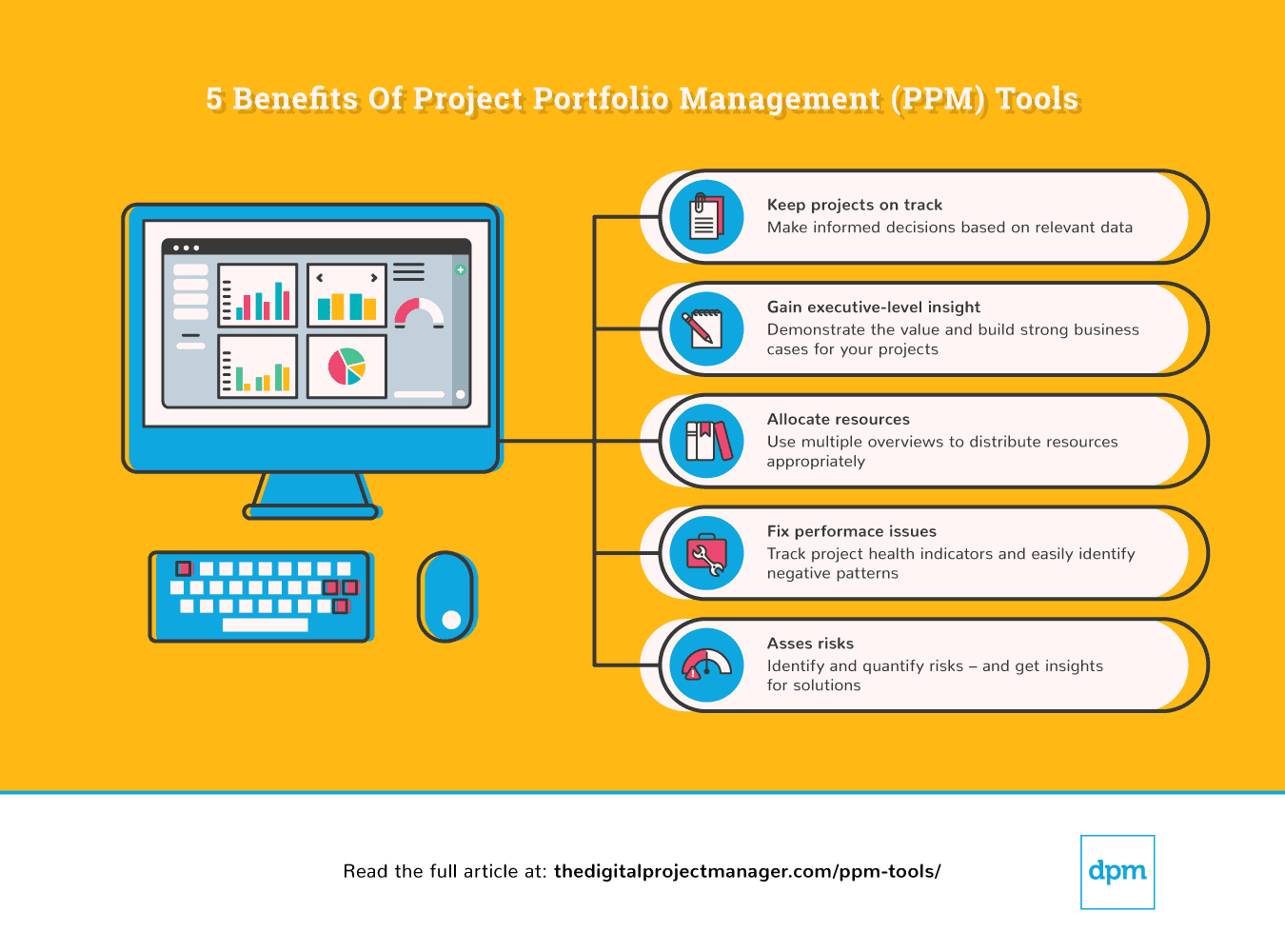
What is the difference between portfolio management and project management?
Portfolio management and project management can easily be confused. While they both focus on projects, the main difference is the objective they pursue. Portfolio management is interested in the relationship between projects in the organization and how it impacts company strategy/goals. On the other hand, project management is interested in the successful completion of projects on time and within budget.
Therefore, PPM tools and project management software will have slightly different features they offer to support these differences in approach.
You can learn more about the difference in our portfolio management vs project management article.
How can I identify my company's PPM maturity level?
According to the Gartner model, you can determine your enterprise’s maturity by placing it into one of the 5 models (in ascending order of maturity):
- Reactive – this accounts for all organizations with an ad-hoc approach to projects. There is a minimal requirement for high-end PPM tools, although they’ll prove necessary for growth.
- Emerging Discipline – next level of management and approach to projects. It involves the use of basic PPM tools but on a more frequent and advanced level.
- Initial Integration – follows a more holistic approach to PPM. This is the point where a larger organization pattern is needed. Risky decisions could surface, and data tracking must be on point.
- Effective Integration – This is the point where automation becomes necessary, and a manager needs as much help as possible in order to execute everything on time, and under budget.
- Effective innovation – This is the end-game everyone strives for. PPMs are fully utilized on multiple levels, and an Enterprise Project Management Office is installed to facilitate the execution.
What's Next?
We have an amazing podcast interview with Michelle Watkins, Founder & Managing Partner at Global PMO Partners. She talks about how to optimize your project management portfolio and how tools & technology were key to streamlining processes at every level and ensuring there was data integrity and real-time visibility.
If you are an experienced PM and are looking for more in-depth information about enterprise-level portfolio management, check out what is enterprise PPM and a 5 step plan to implement EPPM .
Subscribe to our Insider Membership newsletter if you want to stay on top of new content about diverse project management topics.







